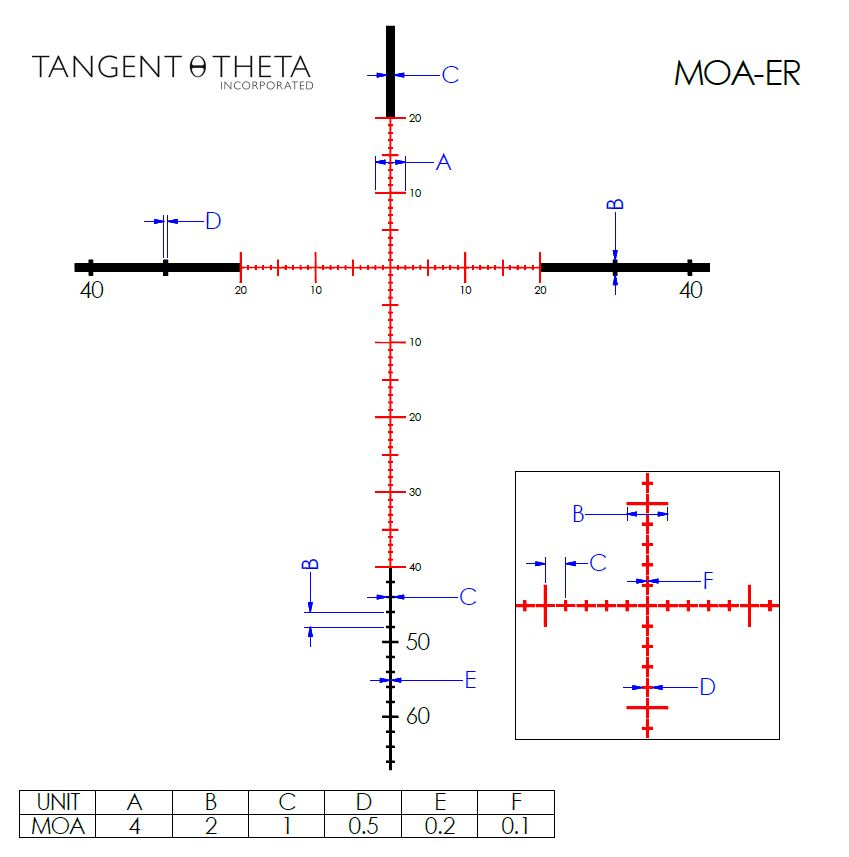MOA-ER Reticle

Features
MOA (Minute of Angle) calibrated reticles and tree pattern reticles are both popular choices for long-range shooting and combining them can provide several benefits. Here's an explanation of how they work together and their benefits.
Understanding MOA
Firstly, let's understand what MOA is. Minute of Angle (MOA) is a unit of angular measurement that is commonly used in the shooting industry. One MOA is equal to 1/60th of a degree or 1.047 inches at 100 yards. It is a way to express the accuracy of a rifle or the adjustment of the rifle scope's turrets. For example, if a rifle can shoot a group of shots that measures 1 MOA at 100 yards, that means the group of shots is 1.047 inches in diameter. Similarly, if a rifle scope is adjusted to move the point of impact by 1 MOA, the bullet's point of impact will move 1.047 inches at 100 yards.
MOA Calibrated Reticles
A MOA calibrated reticle is a reticle with markings that correspond to MOA adjustments. The markings are usually spaced 1 MOA apart, allowing the shooter to estimate the bullet's point of impact and make necessary adjustments to the rifle scope's turrets. The MOA calibrated reticle allows the shooter to adjust for windage and elevation with a quick glance at the reticle.
Tree Pattern Reticles
A tree pattern reticle is a reticle with multiple aiming points arranged in a tree-like pattern. The tree pattern reticle allows the shooter to quickly estimate the range to the target and adjust for bullet drop. The aiming points on the tree pattern reticle are usually spaced at predetermined distances, allowing the shooter to estimate the distance to the target and use the appropriate aiming point.
Benefits of MOA Calibrated Tree Reticles
Using a MOA calibrated tree reticle in long-range competition shooting can provide several benefits, including:
- Faster and more accurate target acquisition: The tree reticle allows the shooter to quickly estimate the range to the target and use the appropriate aiming point, reducing the time it takes to acquire the target. The MOA markings on the reticle provide precise aiming points and help the shooter make quick and accurate adjustments to the scope.
- Improved precision: The MOA calibrated tree reticle provides precise aiming points for both elevation and windage adjustments, improving the precision of the shot placement. The shooter can easily make adjustments to the reticle based on the target's distance and wind conditions, ensuring the bullet lands precisely where it is intended to.
- Flexibility for different ranges: The tree reticle's predetermined aiming points are spaced at various distances, allowing the shooter to use the appropriate aiming point based on the target's range. The MOA markings on the reticle allow the shooter to make precise adjustments to the scope to ensure the bullet hits the target accurately.
- Increased confidence: Using a MOA calibrated tree reticle can increase the shooter's confidence in their ability to hit targets at long ranges. The precise aiming points and ability to make quick adjustments to the scope provide a sense of control and assurance that the shooter can hit the target accurately. Overall, using a MOA calibrated tree reticle in long-range competition shooting can provide significant advantages, including faster and more accurate target acquisition, improved precision, flexibility for different ranges, and increased confidence. It is a useful tool for shooters looking to improve their long-range shooting skills and compete at a higher level.

